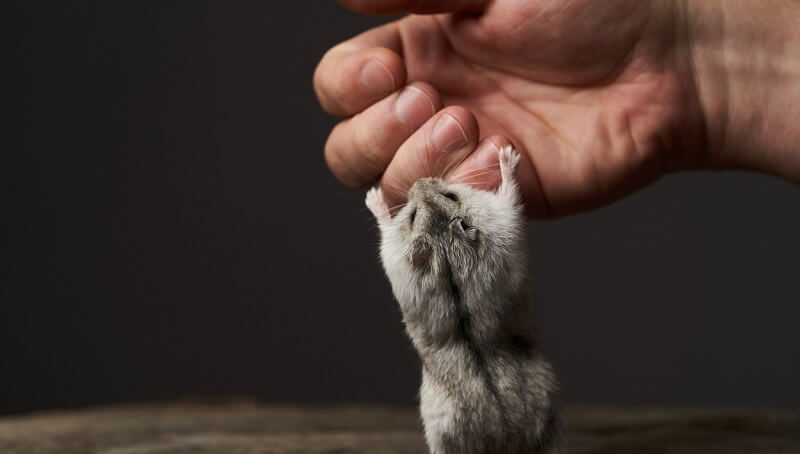Even though they are often considered ideal pets for children and are usually nice and affectionate companions, in some situations hamsters can bite. It is rare for a hamster to be aggressive, yet it usually bites only when it is scared.
Those tiny teeth may not cause as much damage as in the case of other animals, but a bite will do harm and should be discouraged. Fortunately, you can gradually train your hamster to accept being manipulated and stop biting.
Why do hamsters bite?
You might also like my articles about whether:
Gentle hamsters are those who have been manipulated on a regular basis, so they are used to people and don’t get scared easily. On the other hand, hamsters that have not been carried in the hand too long are usually not very gentle and often bite if you try to pick them up.
When dealing with the latter, the most important thing to remember is that they bite because they are afraid, not because they are aggressive.
How to stop the biting
The key to handling a biting hamster is patience. You have to earn its trust, and the process is slow and gradual. This is a good approach even if you have had the hamster for some time and the biting continues to be a problem. It’s also a great way to introduce yourself to a new hamster that can be a little shy at first.
Don’t be discouraged if it takes a month or more to gain the confidence of the hamster.
If it is calm and responds to the process faster than expected, you can shorten the time between the steps. If your hamster is still fearful, go back to the previous step and spend a little more time working on the behavioral correction.
Over time, the hamster will learn to see you as a source of treats and not to be afraid of. It will take some time, but it will be worth it in the end.
In the first week let your hamster get used to you
In the evening, when it is most active, you should spend some time sitting next to the cage and talking to the hamster. You can read to it or even sing if you don’t know what to say. The idea is to let your hamster adapt to your presence, especially your smell and voice.
Remember that moving to a new cage, in a new environment is very stressful, so this period gives the hamster the chance to adapt to the change. At this point, do not try to touch the hamster.
In these first days, it may be necessary to pick it up to clean the cage or return it to the cage after an escape. To pick up the hamster before it has fully learned to accept you, direct it to a corner with a towel, or catch it with a glass, then gently remove it with the towel or glass.
In the second week let your hamster get used to your hand
As you continue to sit next to the cage and talk to it, put your hand into the cage and move it very slowly. On the first day, place your hand right next to the door or above the cage. Every day after that, try to put your hand a little closer.
Don’t try to touch the hamster, but if it becomes curious, let it smell or explore your hand.
In the third week give it rewards
 By now, you may have discovered some of your hamster’s favorite delights. If not, try sunflower seeds, raisins, and apples. While these delicacies should be offered in moderation, they can be excellent training tools.
By now, you may have discovered some of your hamster’s favorite delights. If not, try sunflower seeds, raisins, and apples. While these delicacies should be offered in moderation, they can be excellent training tools.
Give the hamster these goodies from your hand and place them in its cage. Eventually, it will probably come to eat, which will help to gain confidence.
In the fourth week, you can try to pet the hamster
Once the hamster is comfortable eating from your hand, you can try to pet it gently. If it tolerates this, you can move on to the next step of lifting it. Otherwise, continue patiently to offer delights and petting sessions.
In the fifth week try to pick up the hamster
If the hamster accepts treats and allows you to touch it, it is time to try to lift it. Once again, move slowly and let the hamster guide how far you get in each session.
A good approach is to lure your hamster into your hands with treats. Then you can try to take it out of its cage with both hands.
Place a hand on each side of the hamster and then gently put them together under its belly. Form a cup with the hamster in your hands rather than holding it tightly. Hamsters sometimes think that pressure on the back is threatening.
Do not lift the hamster off the ground if it tries to jump out of your hands. At first, keep it just a little above the floor of the cage, gradually raising it a little higher Holding a hamster facing your body can make it less likely to try to jump.
Final words!
Wash your hands before handling the hamster so that your fingers don’t smell like food.
While wearing thick gloves can offer you some protection, wear them only temporarily, as hamsters are best tamed when they become familiar with your perfume, which they cannot detect well through gloves.
If the hamster has caught you by the fingers, do not shake the hand. Try to put your hand gently back into the cage or use the other hand to detach it.
Don’t scream or yell, and never hit the hamster. Try to stay calm and remember that the hamster bites out of fear, not aggression.




